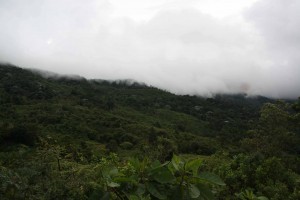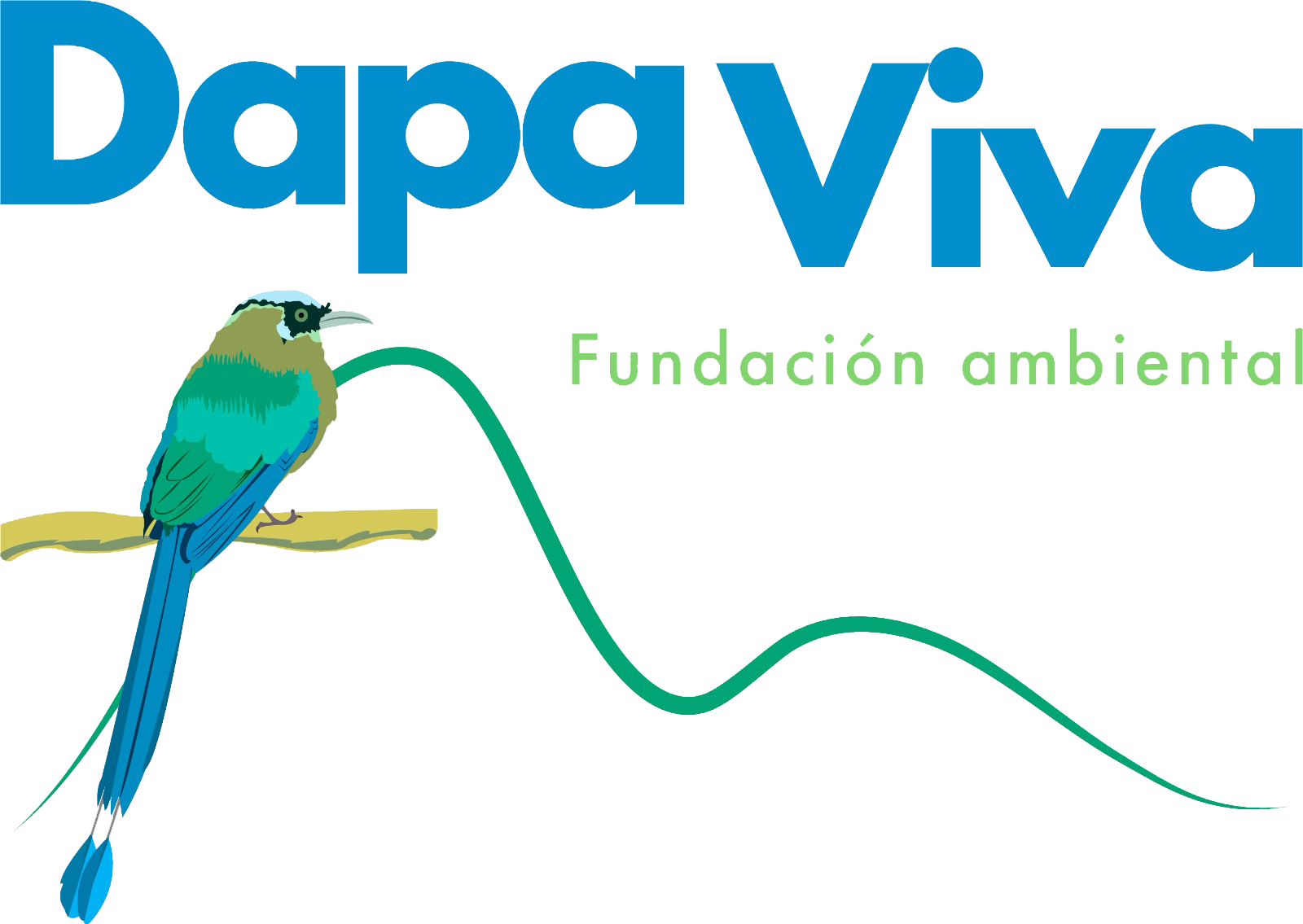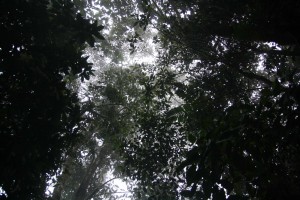[:es]
Bosque de Niebla
Las áreas más importantes para la vida silvestre son las franjas de bosque de niebla (Reserva Forestal Cerro Dapa Carisucio) que ocupan las laderas y cimas de las partes muy altas de Dapa. El bosque de niebla de Dapa está directamente conectado con el bosque de niebla de Chicoral en la ladera oeste de la Cordillera Occidental y está algo conectado con los bosques de niebla de El 18 y San Antonio (al sur, hacia el PNN Farallones de Cali). Lamentablemente, gran parte del bosque original ha sido talado el la Cordillera Occidental para ganadería, cultivos, plantaciones y fincas de recreo.
 In this regions we can find the Tropical Montane Cloud Forest (TMCF) as an hydrologically and ecologically unique ecosystem. TMCF are include all forests in tropical region that are frequently covered in clouds or mist. In addition to rainfall, they capture cloud water dropless that condense on the vegetation, like vascular epiphytes and non-vascular epiphytes (fußnote). This horizontal precipitation significantly influence the hydrological regim and thereby other ecological parameters like soil properties (T. Stadtmüller, 1986). So the result is stemflow and crown dropped water that may provide additional water to the vegetation under the trees (L. A. Bruijnzeel, L.S. Hamilton 2000).
In this regions we can find the Tropical Montane Cloud Forest (TMCF) as an hydrologically and ecologically unique ecosystem. TMCF are include all forests in tropical region that are frequently covered in clouds or mist. In addition to rainfall, they capture cloud water dropless that condense on the vegetation, like vascular epiphytes and non-vascular epiphytes (fußnote). This horizontal precipitation significantly influence the hydrological regim and thereby other ecological parameters like soil properties (T. Stadtmüller, 1986). So the result is stemflow and crown dropped water that may provide additional water to the vegetation under the trees (L. A. Bruijnzeel, L.S. Hamilton 2000).
This event is also called cloud-stripping and it is one of the most essential function that offer the trees for all organisms in this ecosystem (L. A. Bruijnzeel, L.S. Hamilton 2000). Mapping the area of TMCF at the global scale is very complicated because many factors can influence their location (Bubb et al., 2004). But the most accurete estimation by L.A. Bruijnzeel et al. 2010 estimates a area of 2.14.630 km2 for TMCF in the world. Of all the TMCF mapped, 43% occur in Asia (including northern Australia and Oceania), 41% in the Americas (including the Hawai’ian archipelago), and 16% in Africa. In Colombia the area of TMCF is estimated to 9.000.000 ha, these are only 27% of the orignal cover (D. Armenteras, 2002).
TMCF in many parts of the world were rapidly becoming converted or fragmented. Already in the early 1990’s it was clear that TMCF were high on the list of the world’s most threatened terrestrial ecosystems (L. A. Bruijnzeel et al. 2010). In this aspect it’s very important to note, that in the period of time from 1981 to 1990 the annual deforestation rate of montane forest (1.1%) is significantly grater than in lowland tropical rainforests (0.8%) (Charles Doumenge et al. 1995). The remainder area of TMCF in Colombia is highly fragmenteded (N. Tejedor-Garavito et. al, 2012). The high pressure of the growing human population is one deciding reason to run an urgent conservation priority in a national and international way for the colombian TMCF.
In Dapa exist patches of , scrub, shrub, pastures, gardens, crops and tropical mountain cloud forests. In the wooded area of Dapa the dominant tree specie families are Actinidiaceae, Cecropiaceae, Myristicaceae, Vochisiaceae, Laurecaeae. Also recorded were the family species of Erytrocylaceae, Rubiaceae, Tiliaceae, Cecropiaceae, Mimosaceae, Olacaceae, Flacourtaceae, Juglandaceae, Meliaceae, Moraceae. The most abuntant species were Saurauia brachybotrys (Moquillo), Cecropria telealba (Yarumo), Vochysia duquei pilger.
[:en]
Cloud Forest
The most important areas for wildlife are the swaths of cloud forest (Cerro Dapa Carisucio Forest Reserve) that occupy the slopes and ridgelines of the very upper parts of Dapa. The Dapa cloud forest is directly connected to the cloud forest of Chicoral on the west slope of the West Andes and is somewhat connected with the cloud forest of El 18 and San Antonio (to the south towards the PNN Farallones de Cali). Unfortunately, much of the original forest has been cleared in the West Andes for cattle ranching, cultivations, plantations, and weekend homes.
In this regions we can find the Tropical Montane Cloud Forest (TMCF) as an hydrologically and ecologically unique ecosystem. TMCF are include all forests in tropical region that are frequently covered in clouds or mist. In addition to rainfall, they capture cloud water dropless that condense on the vegetation, like vascular epiphytes and non-vascular epiphytes (fußnote). This horizontal precipitation significantly influence the hydrological regim and thereby other ecological parameters like soil properties (T. Stadtmüller, 1986). So the result is stemflow and crown dropped water that may provide additional water to the vegetation under the trees (L. A. Bruijnzeel, L.S. Hamilton 2000). This event is also called cloud-stripping and it is one of the most essential function that offer the trees for all organisms in this ecosystem (L. A. Bruijnzeel, L.S. Hamilton 2000). Mapping the area of TMCF at the global scale is very complicated because many factors can influence their location (Bubb et al., 2004). But the most accurete estimation by L.A. Bruijnzeel et al. 2010 estimates a area of 2.14.630 km2 for TMCF in the world. Of all the TMCF mapped, 43% occur in Asia (including northern Australia and Oceania), 41% in the Americas (including the Hawai’ian archipelago), and 16% in Africa. In Colombia the area of TMCF is estimated to 9.000.000 ha, these are only 27% of the orignal cover (D. Armenteras, 2002). TMCF in many parts of the world were rapidly becoming converted or fragmented. Already in the early 1990’s it was clear that TMCF were high on the list of the world’s most threatened terrestrial ecosystems (L. A. Bruijnzeel et al. 2010). In this aspect it’s very important to note, that in the period of time from 1981 to 1990 the annual deforestation rate of montane forest (1.1%) is significantly grater than in lowland tropical rainforests (0.8%) (Charles Doumenge et al. 1995). The remainder area of TMCF in Colombia is highly fragmenteded (N. Tejedor-Garavito et. al, 2012). The high pressure of the growing human population is one deciding reason to run an urgent conservation priority in a national and international way for the colombian TMCF. In Dapa exist patches of , scrub, shrub, pastures, gardens, crops and tropical mountain cloud forests. In the wooded area of Dapa the dominant tree specie families are Actinidiaceae, Cecropiaceae, Myristicaceae, Vochisiaceae, Laurecaeae. Also recorded were the family species of Erytrocylaceae, Rubiaceae, Tiliaceae, Cecropiaceae, Mimosaceae, Olacaceae, Flacourtaceae, Juglandaceae, Meliaceae, Moraceae. The most abuntant species were Saurauia brachybotrys (Moquillo), Cecropria telealba (Yarumo), Vochysia duquei pilger.
[:de]
Bosque de Niebla
Las áreas más importantes para la vida silvestre son las franjas de bosque de niebla (Reserva Forestal Cerro Dapa Carisucio) que ocupan las laderas y cimas de las partes muy altas de Dapa. El bosque de niebla de Dapa está directamente conectado con el bosque de niebla de Chicoral en la ladera oeste de la Cordillera Occidental y está algo conectado con los bosques de niebla de El 18 y San Antonio (al sur, hacia el PNN Farallones de Cali). Lamentablemente, gran parte del bosque original ha sido talado el la Cordillera Occidental para ganadería, cultivos, plantaciones y fincas de recreo.
In this regions we can find the Tropical Montane Cloud Forest (TMCF) as an hydrologically and ecologically unique ecosystem. TMCF are include all forests in tropical region that are frequently covered in clouds or mist. In addition to rainfall, they capture cloud water dropless that condense on the vegetation, like vascular epiphytes and non-vascular epiphytes (fußnote). This horizontal precipitation significantly influence the hydrological regim and thereby other ecological parameters like soil properties (T. Stadtmüller, 1986). So the result is stemflow and crown dropped water that may provide additional water to the vegetation under the trees (L. A. Bruijnzeel, L.S. Hamilton 2000).
This event is also called cloud-stripping and it is one of the most essential function that offer the trees for all organisms in this ecosystem (L. A. Bruijnzeel, L.S. Hamilton 2000). Mapping the area of TMCF at the global scale is very complicated because many factors can influence their location (Bubb et al., 2004). But the most accurete estimation by L.A. Bruijnzeel et al. 2010 estimates a area of 2.14.630 km2 for TMCF in the world. Of all the TMCF mapped, 43% occur in Asia (including northern Australia and Oceania), 41% in the Americas (including the Hawaian archipelago), and 16% in Africa. In Colombia the area of TMCF is estimated to 9.000.000 ha, these are only 27% of the orignal cover (D. Armenteras, 2002).
TMCF in many parts of the world were rapidly becoming converted or fragmented. Already in the early 1990’s it was clear that TMCF were high on the list of the world’s most threatened terrestrial ecosystems (L. A. Bruijnzeel et al. 2010). In this aspect it’s very important to note, that in the period of time from 1981 to 1990 the annual deforestation rate of montane forest (1.1%) is significantly grater than in lowland tropical rainforests (0.8%) (Charles Doumenge et al. 1995). The remainder area of TMCF in Colombia is highly fragmenteded (N. Tejedor-Garavito et. al, 2012). The high pressure of the growing human population is one deciding reason to run an urgent conservation priority in a national and international way for the colombian TMCF.
In Dapa exist patches of , scrub, shrub, pastures, gardens, crops and tropical mountain cloud forests. In the wooded area of Dapa the dominant tree specie families are Actinidiaceae, Cecropiaceae, Myristicaceae, Vochisiaceae, Laurecaeae. Also recorded were the family species of Erytrocylaceae, Rubiaceae, Tiliaceae, Cecropiaceae, Mimosaceae, Olacaceae, Flacourtaceae, Juglandaceae, Meliaceae, Moraceae. The most abuntant species were Saurauia brachybotrys (Moquillo), Cecropria telealba (Yarumo), Vochysia duquei pilger.
[:]


Debe estar conectado para enviar un comentario.